Detect, disassemble, study, solder and jam police police and lidars
A long time ago, in 1902, three policemen were sitting in the bushes (at 1 mile intervals), each with a stopwatch and a telephone. Car rushes past the first car, he immediately notes the time and calls the second, the second does mathematical calculations and the third, and the car stops. ( proof )

"Antiradar" in the analysis. ( The radar detector is a passive receiver of police radar signals warning the driver to observe the speed limit.)
Today we will discuss devices for electronic warfare on our roads.
While radar detectors and radar detectors are not banned here, the EW is not being conducted here, but in some countries the war is going full. We can only prepare.
')
Radar, radar detectors, radar detector detectors. About what are, how to make / saw yourself and both.
(Thanks to the online store fonarimarket.ru for the equipment provided)

The world's first radar
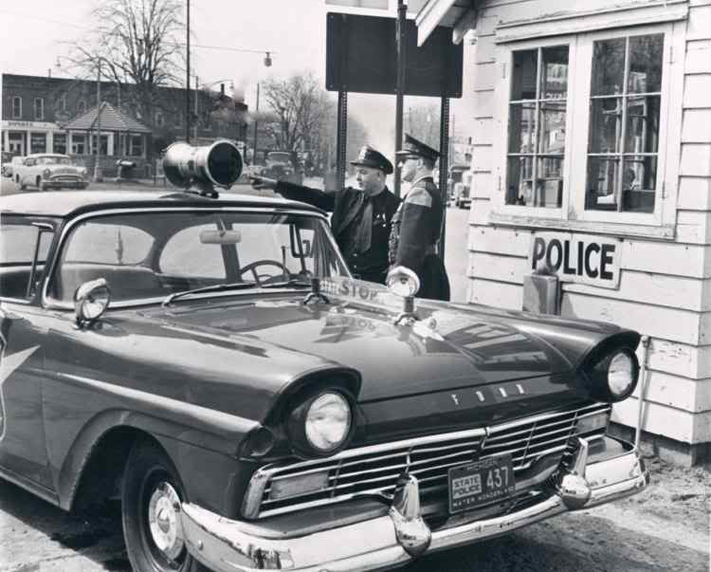
The world's first car radar
One of the first police radar of the mid-20th century:
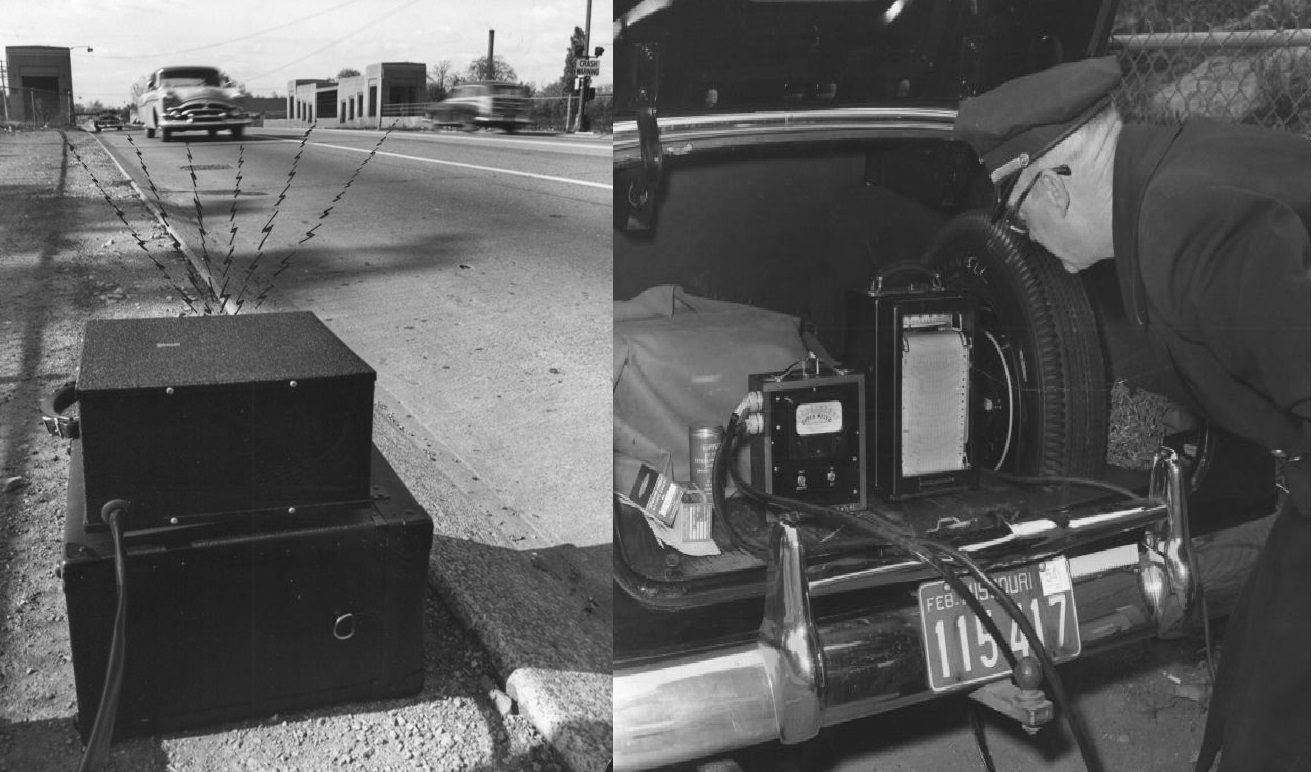

blogs.sydneylivingmuseums.com.au/justice/index.php/2011/04/05/a-deterrent-for-scorchers
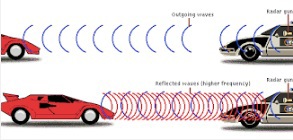 Radio frequency radar (Doppler radar) emits a high frequency radio signal of X-, K- or Ka-band in the direction of the car. The frequency of the reflected signal varies in proportion to the speed of movement of the object. Having received the reflected signal, the radar measures the frequency deviation and calculates the speed of the car. The resulting speed value is displayed on the radar display or transmitted to the situational center, in case the radar is stationary.
Radio frequency radar (Doppler radar) emits a high frequency radio signal of X-, K- or Ka-band in the direction of the car. The frequency of the reflected signal varies in proportion to the speed of movement of the object. Having received the reflected signal, the radar measures the frequency deviation and calculates the speed of the car. The resulting speed value is displayed on the radar display or transmitted to the situational center, in case the radar is stationary.
The ranges of traffic police radars are determined by international agreements. Three ranges are certified in Russia; the frequencies of all radars used by traffic police in our country must be within their limits.
X-band (operating frequency 10.525 GHz). The first detectors worked in this range, but today they have almost completely replaced the equipment using other frequencies, although some foreign and Russian (BARRIER, FALCON) continue to use it.
K-band (carrier frequency of 24.150 GHz). Basic for the vast majority of DPS radars in the world. Devices operating in it are more compact, but have a greater detection range than X-band devices.
L-band (1-2GHz).
The VG-2 band (16000 MHz) is the band that the police of some European countries (where radar detectors are prohibited) use to detect cars with radar detectors.
The promising ranges of K a and K u in Russia have not yet been certified, and radar cameras of these ranges are not used here. The detectors used by motorists are tuned to the ranges of the traffic police radar of all frequencies used in our country.
 The second type of police radar is laser radar (lidar) or, as it is not rarely called, optical. Lidar emits short laser pulses outside the visual range (IR), with a fixed time interval, in the direction of the car. These pulses are reflected from the vehicle and are received by a laser meter. Lidar captures the change in the distance to the object by the delay time of each reflected pulse. A digital lidar device calculates the speed of a vehicle using range data for a fixed amount of time.
The second type of police radar is laser radar (lidar) or, as it is not rarely called, optical. Lidar emits short laser pulses outside the visual range (IR), with a fixed time interval, in the direction of the car. These pulses are reflected from the vehicle and are received by a laser meter. Lidar captures the change in the distance to the object by the delay time of each reflected pulse. A digital lidar device calculates the speed of a vehicle using range data for a fixed amount of time.
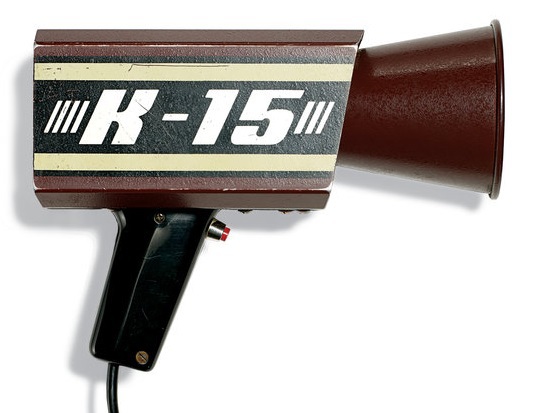
Legality
The use of radar detectors is officially authorized in Russia, Ukraine, Belarus, Moldova, Kazakhstan and all other countries of the Commonwealth, in the USA (except for the state of Virginia and in Washington, DC), Great Britain, Iceland, Bulgaria, Romania, Slovenia, Albania, Israel, Japan, India, Pakistan, Taiwan, New Zealand.
Radar detectors are prohibited for use in Canada (except British Columbia, Alberta and Saskatchewan), Brazil, Finland, Norway, Sweden, Belgium, Ireland, Switzerland, Denmark, Germany, Austria, Holland, Luxembourg, France, Portugal, Italy , Greece, Croatia, Serbia, Slovakia, Poland, Hungary, Bosnia, Czech Republic, Estonia, Latvia, Lithuania, Turkey, Jordan, Singapore, Malaysia, Egypt, Saudi Arabia, United Arab Emirates, South Africa, Australia (excluding the state of Western Australia).
Story

The world's first radar detector for motorists
Promoted such gadgets through the magazine Popular Electronics (1961):
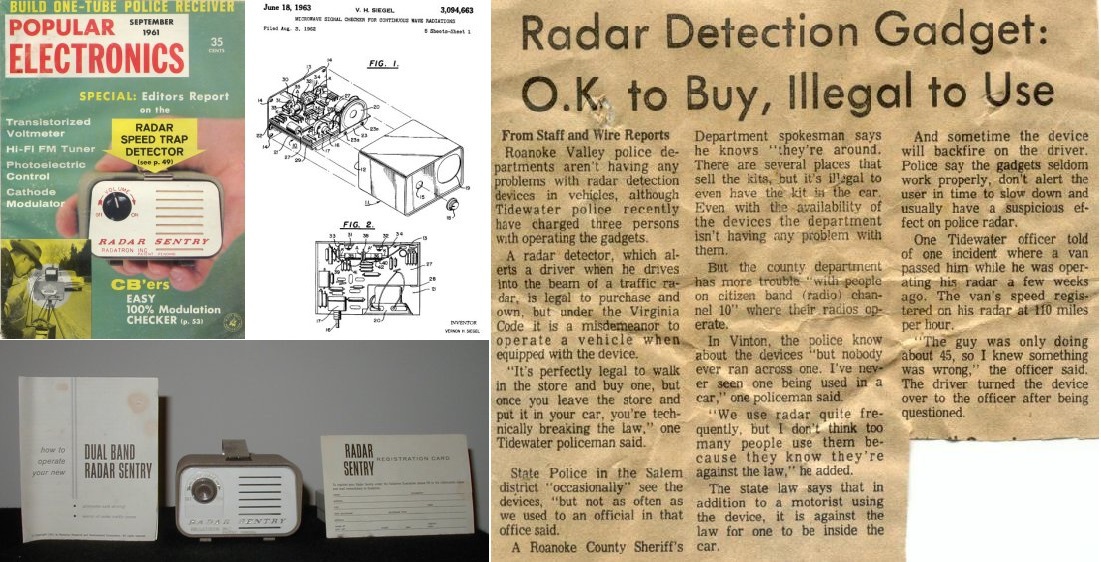
A source
Later models:
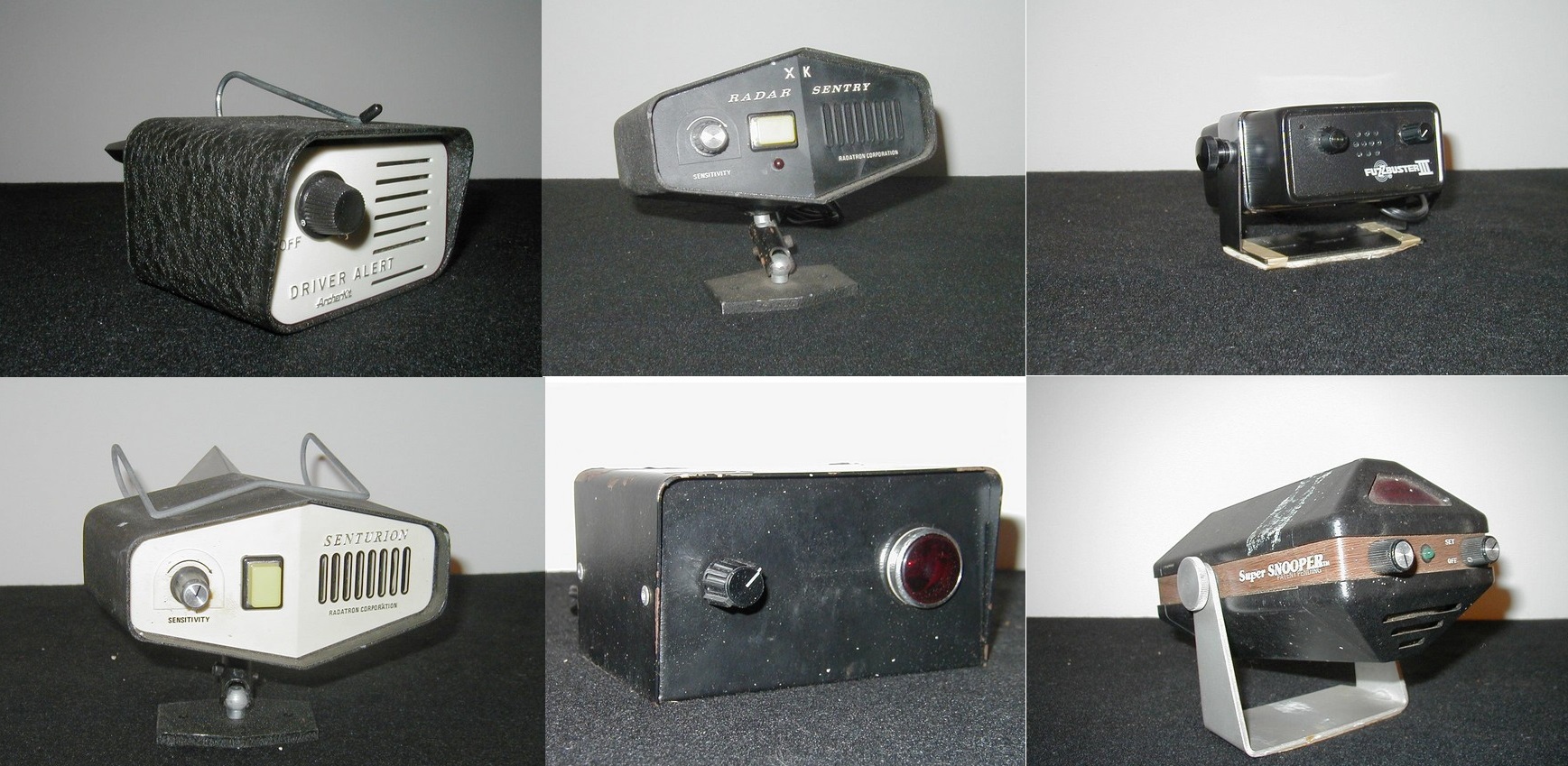
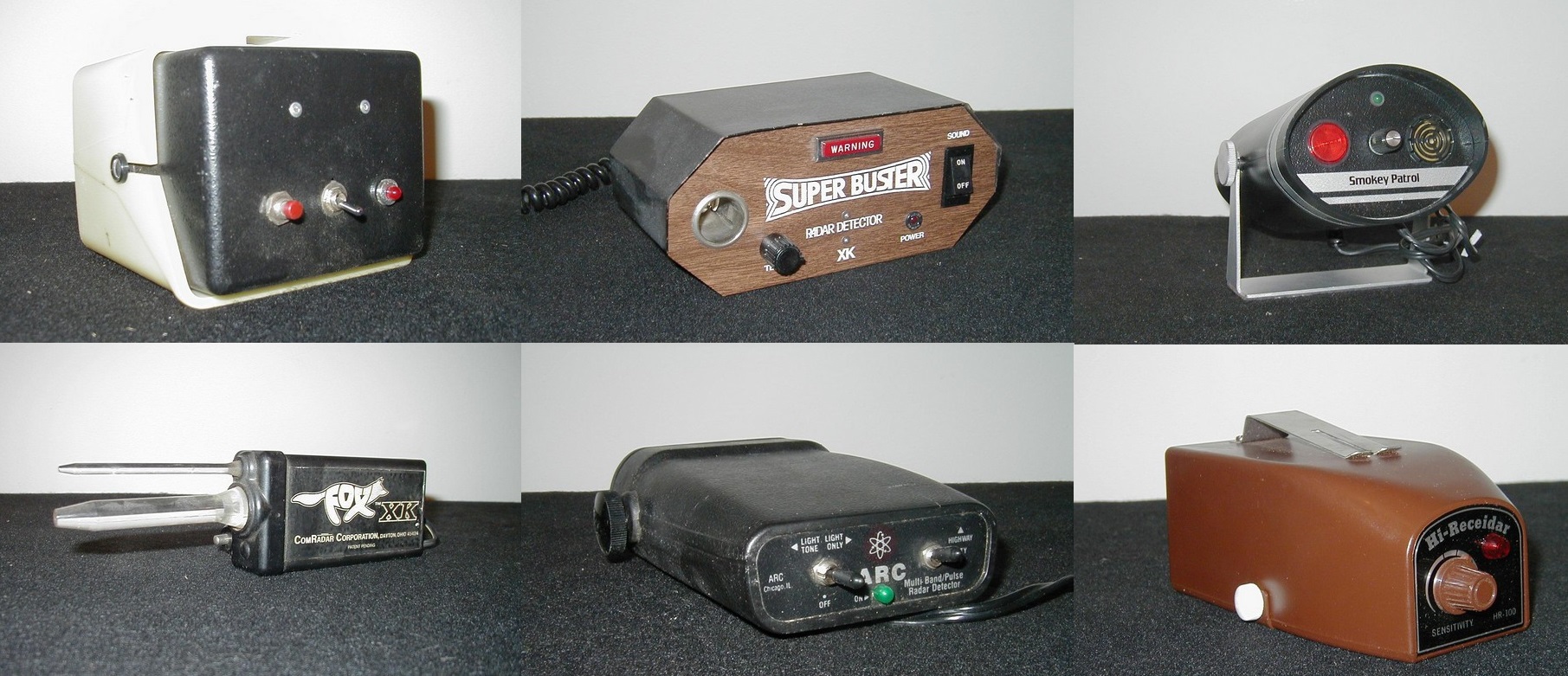
Museum of radar detectors - www.radardetectormuseum.com
The insides of a modern radar detector SHO-ME 520 STR
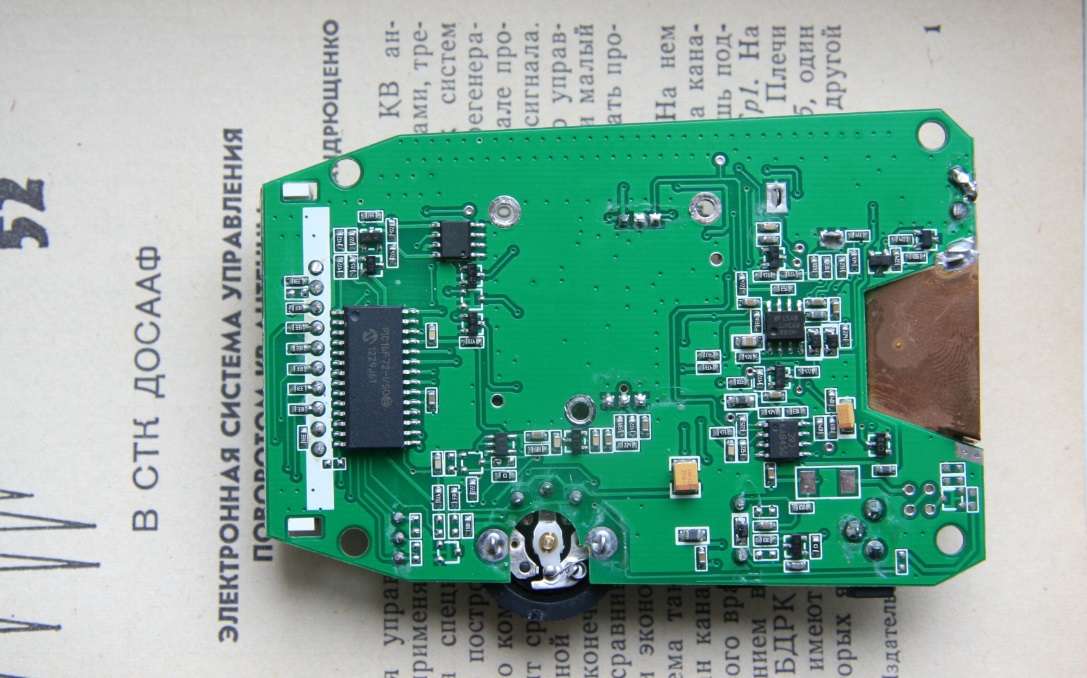
Bottom view
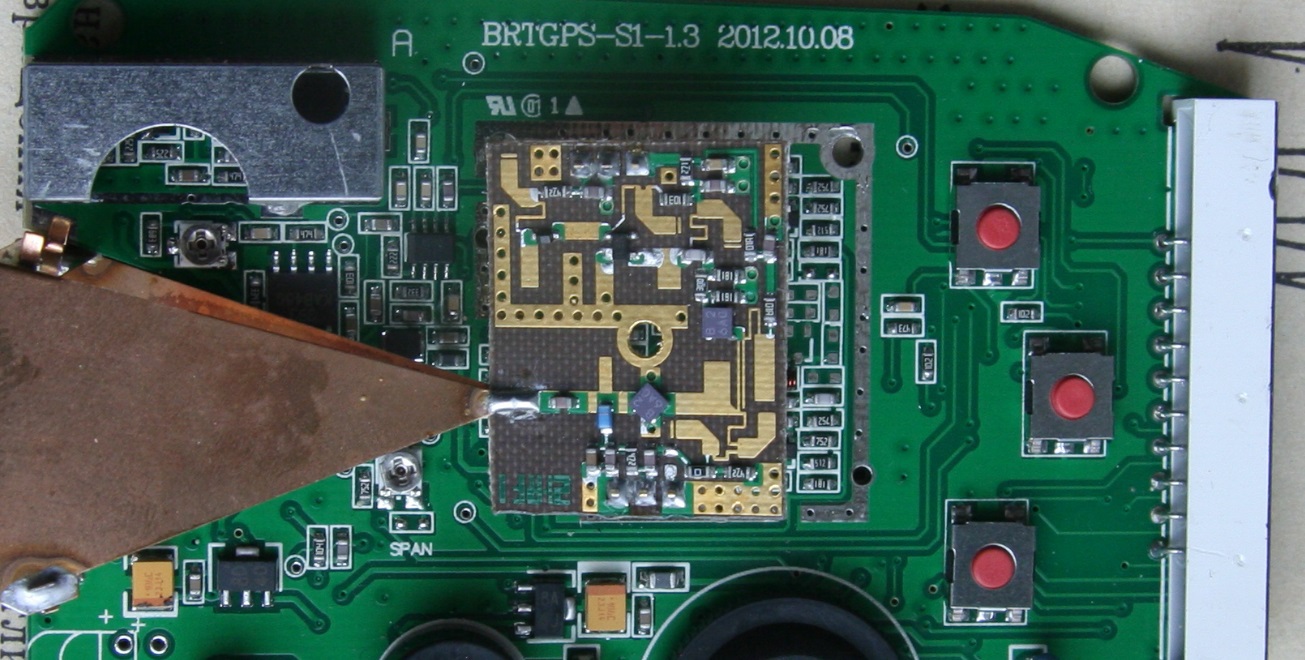
With the radiator removed (corrected in the comments - this is an RF screen. It also shields the local oscillator radiation, and also protects the receiving path from external interference. Thanks r00tGER ). On the left above is a laser detector, below is a copper horn antenna. In the center - the RF module. To the right - 3 control buttons. Right (white) - display
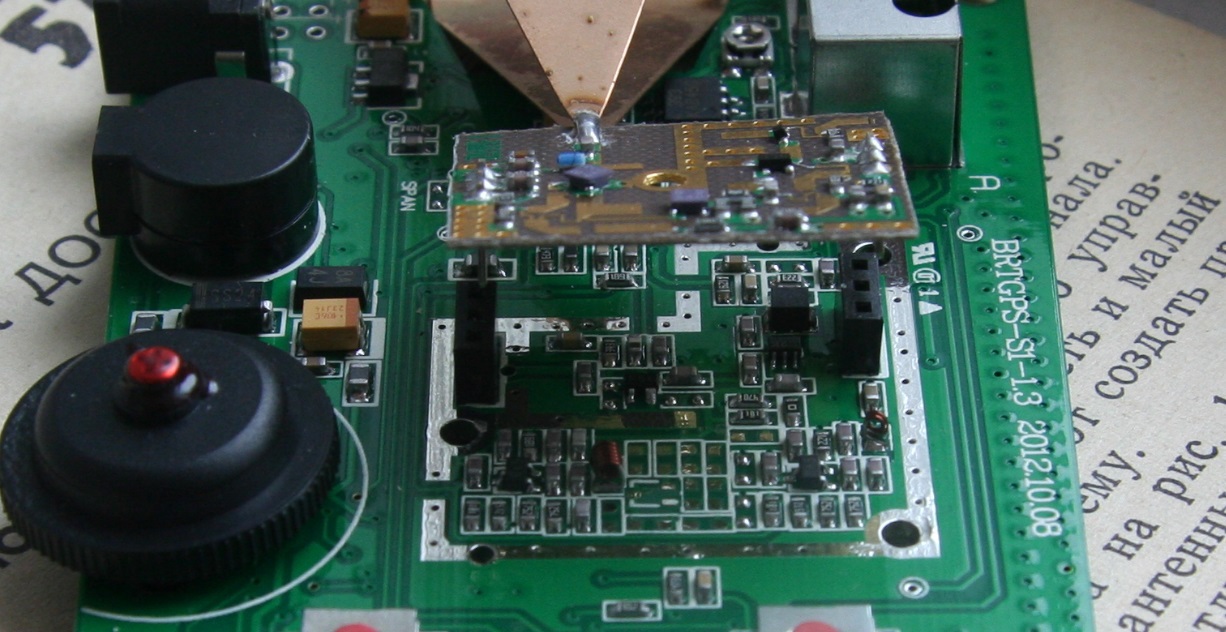
Under HF screen
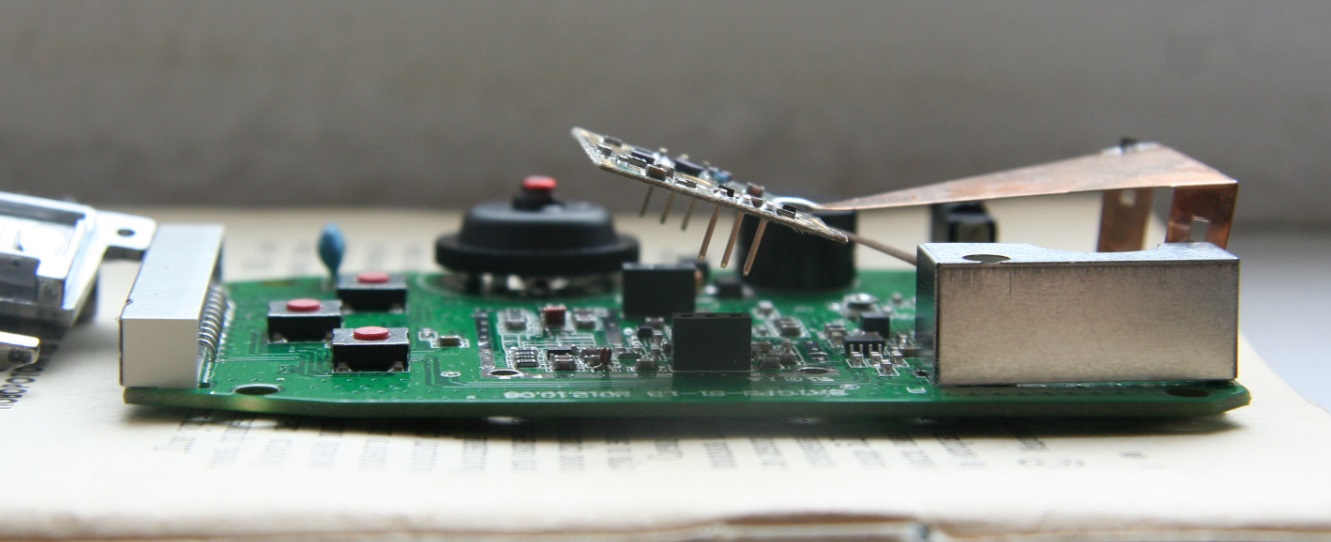
False signals are radio signals from outside devices operating in police radar bands, but with no relation to the latter. For example, automatic shop doors can operate in the X- and K-bands, satellite equipment signals can be detected by the X-band radar detector, radio signals from all bands can be detected in areas adjacent to airports, as well as laser signals.
The radar detectors use software and hardware methods of protection against spurious radio signals. Hardware methods involve the installation of specialized filters in the receiving device of the radar detector, and software methods include special algorithms that can identify the radar signal and cut off its signal from interference. But sometimes these methods are not enough, especially when using a radar detector in urban environments with a lot of interference from foreign devices. To do this, all modern radar detectors have a manual change in the sensitivity of the device - switching between the "City" and "Route" modes. Depending on the “jamming” environment, the driver can independently adjust the sensitivity of his device and minimize the number of false alarms of the radar detector.
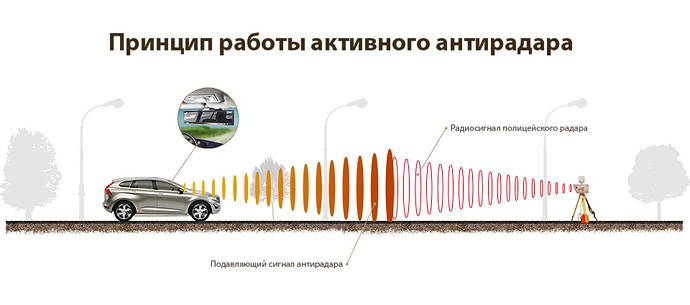
Antiradar - the device of the active type. It is equipped not only with a radio receiver for signal detection, but also with a radio transmitter that emits signal-to-noise. It is this signal that violates the work of police radar: it mixes the signal coming from the radar with radio noise (“white noise”). The radar radio receiver receives a distorted signal and cannot determine the speed of the vehicle to which the radio signal was directed.
These devices are prohibited almost everywhere. This device is included in the list of devices included in the Law “On counteraction to traffic organs”.
Laser Antiradar
During their work in response to the signal sent by the police radar, the laser anti-radar detectors send their own out-of-phase. As a result, the policeman gets a speed value that is too low. It should be noted that the range of prices for devices of this type is significant. This is explained both by the brand of the manufacturer and its “promotion” on the market, and by the method of manufacture and the components used. The most expensive are laser anti-radars of a hidden or separated installation, as well as capable of simultaneously processing a large number (up to eight) signals at the same time, determining the power and signal level.
The use of “jammers” against lidars is also not recommended, since they are already included in the list of the Law “On Countering Road Traffic Organs”.
Demonstration of laser jammer:
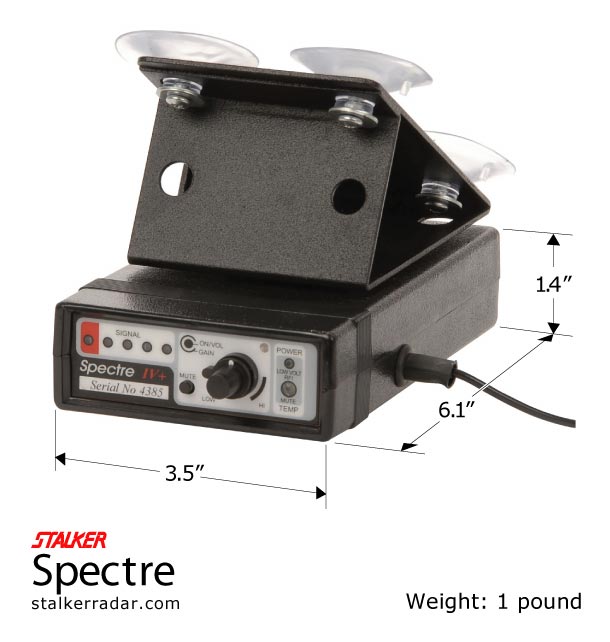
Highly sensitive direction finder
In a number of foreign countries, according to the law, radar detectors are prohibited. In order to determine whether a radar detector is in a car or not, the VG-2 system (16000 MHz) was invented. The principle of operation - the car is irradiated with a signal of a certain frequency, since Inside the radar detector there are a lot of radio parts, they induce a “noise” on this signal and, by their presence or absence, the device issues whether the radar detector is in the car or not.
Modern radar detectors have the function of detecting VG-2 devices (in fact, when a VG-2 is detected, the radar simply turns off for a while).
All radar detectors can be divided into 2 main groups - heterodyne and direct amplification. Direct amplification detectors cannot initially be detected by such devices. they have no structural radiation. In heterodyne detectors in the process of signal processing uses the local oscillator, which is the source of radiation (minimal, but there). It is this radiation that can be captured by ultrasensitive devices for searching a radar detector at a distance. The distance can reach several hundred meters.
With the VG-2 option in the detector, the radar detector, besides the usual radar frequencies, also scans this selected frequency for the signal of such an instrument. When a signal is detected, all the local oscillators in the detector are turned off, and with them the reception of radar signals and thus the detector is protected from detection. The detector is fully turned on only after the signal disappears in the VG-2 range.
In addition to the VG-2, which is already an outdated technology, there are Spectrum-type devices that also remotely detect the presence of a heterodyne radar detector in a car. Unlike VG-2, the Spectrum does not have a dedicated frequency and therefore cannot be detected in advance. The only protection against detection by Spectra is to reduce the level of radiation of the local oscillator due to shielding and the use of low-noise signal amplifiers.
Counteraction to the detector of radar detectors
1. Not to use a local oscillator in the design of the radar detector - there are no radiating elements, there is no problem, but the direct-amplification radar detector is not very sensitive;
2You can counteract VG-2 systems by turning off the local oscillator, and this is done in most radar detectors. As soon as the radar detector detects a signal in the VG-2 range, it turns off the local oscillator and thus interferes with detection. When using this method, there is one very important side effect - at the time of detecting a VG-2 signal, the radar detector cannot detect radar signals since its local oscillator is disabled. This method works only with VG-2, and Spectrum systems have a different principle and this method is not possible.
3To counteract Spectra manufacturers radar detector all available methods to reduce the radiation emitted by the local oscillator to the outside. For this, shielding, metal shells are used, resonance tuning is one of the passive methods. Active include the use of low-noise amplifiers (LNA), the reduction of the local oscillator, etc. methods. The use of several methods at the same time is able to protect the radar detector from detecting, but radar detectors that are not completely detectable is not much, but their number is constantly increasing as manufacturers move to higher technologies. The first completely undetectable radar detector was the Beltronics STi. When using this method of counteraction there are no side effects.
In Russia, the functions of VG and Specter are not relevant, since we do not have a ban on the use of radar detectors, although in the media every now and then there are notes about attempts by the authorities of individual regions to impose such restrictions, such as in Tatarstan.
A large box catches a small box:
What is happening in the environment of DIY and hacker conferences

Scheme for self-assembly radar detector for radio amateurs (1958)
The hacker's job of making coffee cans radar is based on the scientific publication of a doctor from MIT, where the ability to create 2D and 3D images using radar synthesizing aperture is described.

Massachusetts even made a course on this topic
DEFCON 19: Build your own Synthetic Aperture Radar:
For 900 bucks you can buy a set for the assembly :

Anboxing training set with cans:
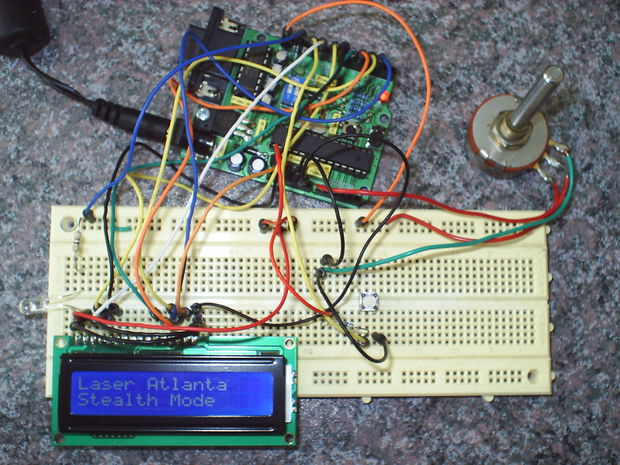
Test your radar detector or laser jammer with
this traffic enforcement LIDAR gun simulator If you want to build your own laser jammer or laser radar detector, it is useful to you is a device that simulates the work of police laser detection systems.
The device mimics one of 11 systems:
each of which works on 904nM, some systems emit 100 pulses per second, some - 238.
We test our gadget for vulnerabilities.

From a toy:
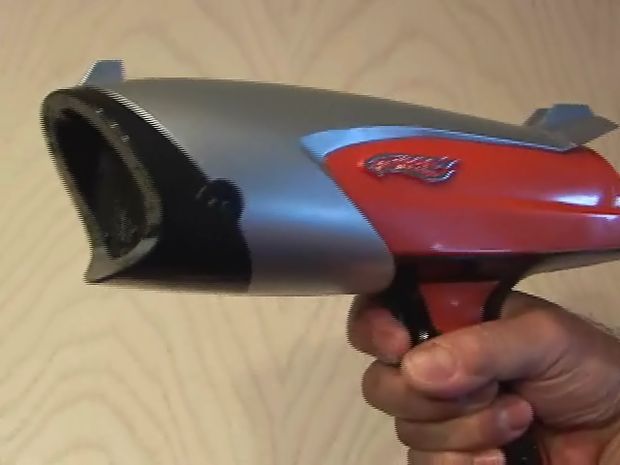
For $ 25
With a saw, washer and bottle:

Make a device for those who want to become a policeman:
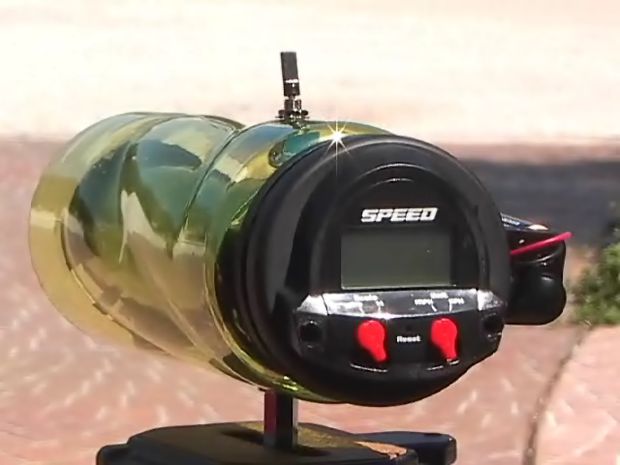
Another comrade was not satisfied with the power of the previous "toy" (10 meters), and he washed down his horn antenna and amp:
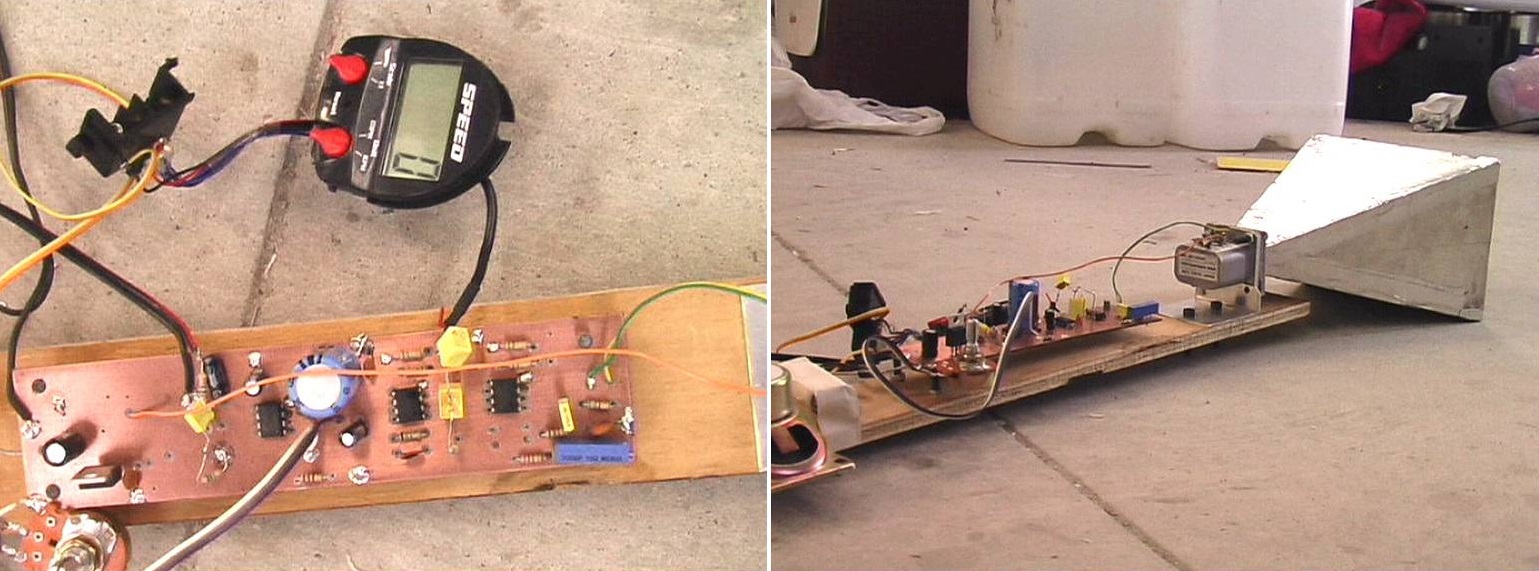
Handyman wants to measure the speed of airplanes. He figured out the relics, but the next step is to upgrade the microchip, because it has a speed limit of 100 mph and he needs more. ( Source )
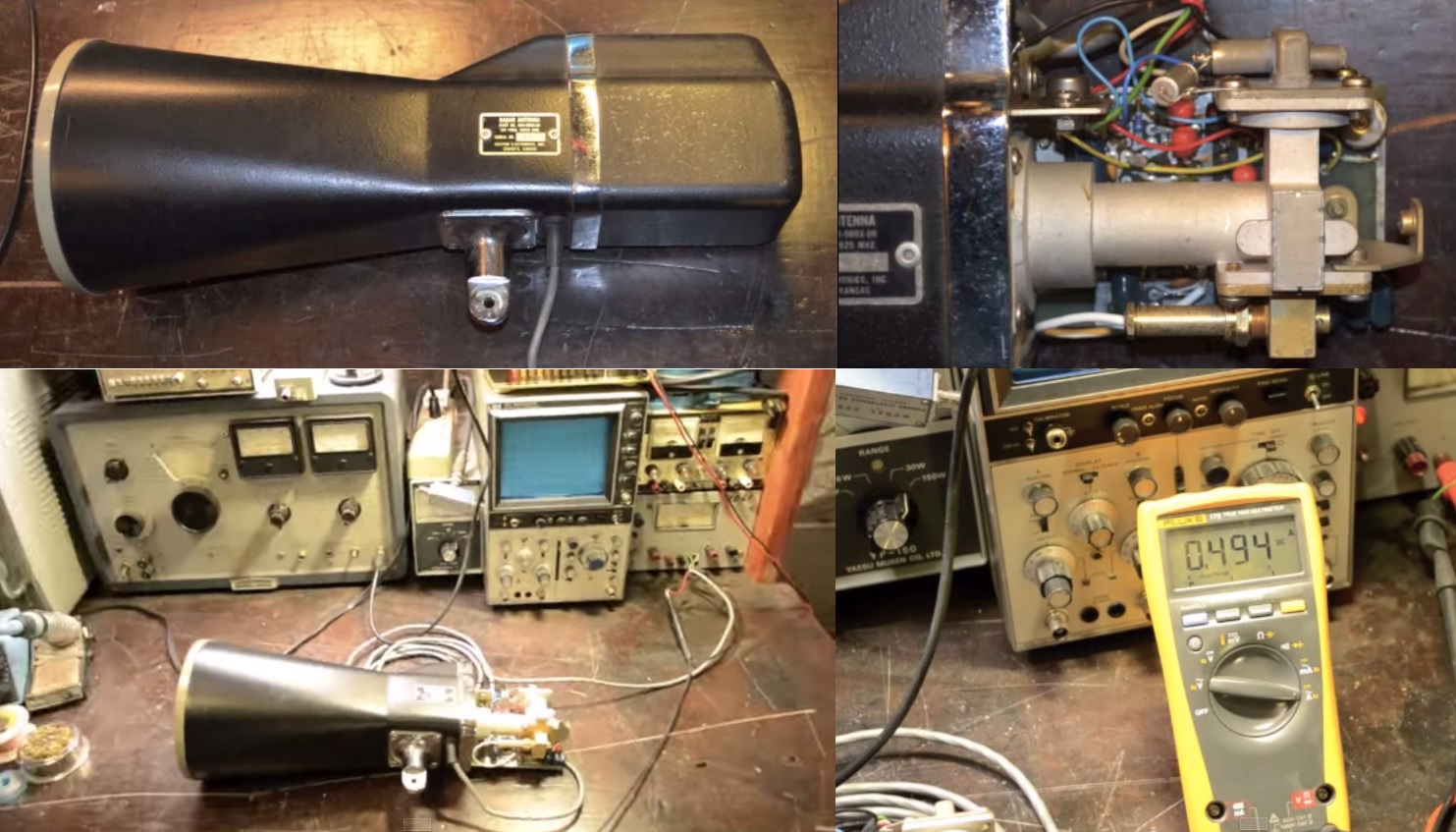
Nadybav in the attic of grandfather's radar, the craftsman poked around with the oscilloscope and soldered the adapter from the radar to the laptop through the audio input. And then successfully processed the signal on the computer.
a source
PS

"Antiradar" in the analysis. ( The radar detector is a passive receiver of police radar signals warning the driver to observe the speed limit.)
Today we will discuss devices for electronic warfare on our roads.
While radar detectors and radar detectors are not banned here, the EW is not being conducted here, but in some countries the war is going full. We can only prepare.
Electronic Warfare (EW) is a type of warfare that influences radio emissions (radio interference) on the radio electronic means of control, communication and reconnaissance systems of the enemy in order to change the quality of military information circulating in them, protect their systems from similar effects. (properties of the medium) of the propagation of radio waves. WikipediaHow to resist someone who is trying to remove information about you without your knowledge and how to protect your “personal data” from unauthorized removal.
')
Radar, radar detectors, radar detector detectors. About what are, how to make / saw yourself and both.
(Thanks to the online store fonarimarket.ru for the equipment provided)
Radar

The world's first radar

The world's first car radar
One of the first police radar of the mid-20th century:


blogs.sydneylivingmuseums.com.au/justice/index.php/2011/04/05/a-deterrent-for-scorchers
 Radio frequency radar (Doppler radar) emits a high frequency radio signal of X-, K- or Ka-band in the direction of the car. The frequency of the reflected signal varies in proportion to the speed of movement of the object. Having received the reflected signal, the radar measures the frequency deviation and calculates the speed of the car. The resulting speed value is displayed on the radar display or transmitted to the situational center, in case the radar is stationary.
Radio frequency radar (Doppler radar) emits a high frequency radio signal of X-, K- or Ka-band in the direction of the car. The frequency of the reflected signal varies in proportion to the speed of movement of the object. Having received the reflected signal, the radar measures the frequency deviation and calculates the speed of the car. The resulting speed value is displayed on the radar display or transmitted to the situational center, in case the radar is stationary.The ranges of traffic police radars are determined by international agreements. Three ranges are certified in Russia; the frequencies of all radars used by traffic police in our country must be within their limits.
X-band (operating frequency 10.525 GHz). The first detectors worked in this range, but today they have almost completely replaced the equipment using other frequencies, although some foreign and Russian (BARRIER, FALCON) continue to use it.
K-band (carrier frequency of 24.150 GHz). Basic for the vast majority of DPS radars in the world. Devices operating in it are more compact, but have a greater detection range than X-band devices.
L-band (1-2GHz).
The VG-2 band (16000 MHz) is the band that the police of some European countries (where radar detectors are prohibited) use to detect cars with radar detectors.
The promising ranges of K a and K u in Russia have not yet been certified, and radar cameras of these ranges are not used here. The detectors used by motorists are tuned to the ranges of the traffic police radar of all frequencies used in our country.
 The second type of police radar is laser radar (lidar) or, as it is not rarely called, optical. Lidar emits short laser pulses outside the visual range (IR), with a fixed time interval, in the direction of the car. These pulses are reflected from the vehicle and are received by a laser meter. Lidar captures the change in the distance to the object by the delay time of each reflected pulse. A digital lidar device calculates the speed of a vehicle using range data for a fixed amount of time.
The second type of police radar is laser radar (lidar) or, as it is not rarely called, optical. Lidar emits short laser pulses outside the visual range (IR), with a fixed time interval, in the direction of the car. These pulses are reflected from the vehicle and are received by a laser meter. Lidar captures the change in the distance to the object by the delay time of each reflected pulse. A digital lidar device calculates the speed of a vehicle using range data for a fixed amount of time.
Big Brother's Guns
Radar "Iskra-1"
 The Iskra-1 radar is a reliable and efficient speed meter operating in the K-band. For 15 years, the radar has been successfully used by road monitoring services to control the speed limit on the roads of Russia. Iskra-1 operates at double the frequency of the K-band, which significantly increases the reliability of measurements under adverse weather conditions. A distinctive feature of the Iskra-1 models is a single-pulse method for measuring speed. This mode provides a high speed device: the parameters of the movement of the car radar counts in just 0.2 seconds. At the same time, the radar is almost invisible to all non-adapted for Russian conditions radar detectors of foreign production: they all perceive the Iskra short-pulse signal as a hindrance.
The Iskra-1 radar is a reliable and efficient speed meter operating in the K-band. For 15 years, the radar has been successfully used by road monitoring services to control the speed limit on the roads of Russia. Iskra-1 operates at double the frequency of the K-band, which significantly increases the reliability of measurements under adverse weather conditions. A distinctive feature of the Iskra-1 models is a single-pulse method for measuring speed. This mode provides a high speed device: the parameters of the movement of the car radar counts in just 0.2 seconds. At the same time, the radar is almost invisible to all non-adapted for Russian conditions radar detectors of foreign production: they all perceive the Iskra short-pulse signal as a hindrance.
Specifications
Type of device radar
Operating frequency of the speed meter 24050–24250 MHz (K-band)
Driving Directions All Directions
Speed measurement mode stationary, patrol (in motion)
Detection range up to 800 m
Speed range 30–220 km / h
Measurement error ± 1 km / h
The lineup
"Iskra-1B" is designed to work in a stationary mode, mainly in one direction. The radar allows in virtually any conditions to allocate in a traffic flow a vehicle with the highest speed exceeding the flow velocity by only 5 km / h.
The Iskra-1D is the first Russian radar capable of operating in all directions on a moving patrol vehicle. In one second, the radar manages to make a fivefold measurement of its own speed and target speed, eliminate possible errors, process the measurement results and display them on the board, consistently displaying the target speed, its own speed and time from the beginning of the measurement.
Radar "Sokol-M"
 Mobile radar "Sokol-M" is an autonomous radar velocity meter operating in the outdated X-band. The device is designed to determine the speed of oncoming cars only. Overall, easy to use, the radar is able to control the speed of both individual cars and moving in the stream at a distance of 300-500 m. It is perfectly recognized by “white” radar detectors of any price category. The Sokol-M radar was discontinued in 2008, but due to its high reliability, ease of handling and relatively small price, it is widely used now in Russia and the Commonwealth countries.
Mobile radar "Sokol-M" is an autonomous radar velocity meter operating in the outdated X-band. The device is designed to determine the speed of oncoming cars only. Overall, easy to use, the radar is able to control the speed of both individual cars and moving in the stream at a distance of 300-500 m. It is perfectly recognized by “white” radar detectors of any price category. The Sokol-M radar was discontinued in 2008, but due to its high reliability, ease of handling and relatively small price, it is widely used now in Russia and the Commonwealth countries.
Specifications
Type of device radar
Operating frequency of the speed meter 10500–10550 MHz (X-band)
Driving Directions All Directions
Speed measurement mode stationary, patrol (in motion)
Detection range up to 600 m
Speed range 20–250 km / h
Measurement error ± 2 km / h
The lineup
Sokol-M-S is designed for stationary control of speed limits and has an adjustable range. All Sokol-M models operate in Ultra-X pulsed mode, which makes these radars hardly perceptible for low-price radar detectors and models that are not adapted for use in the Russian context.
Sokol-MD is designed to measure the speed of oncoming and passing vehicles in a moving patrol vehicle.
Sokol-Visa, a mobile complex for measuring speed and video recording, is a Sokol-M radar, paired with a digital video camera. The system operates in a stationary mode (it is installed mainly on a fixed patrol vehicle) and can measure the speed of oncoming vehicles only. The Sokol-Visa complex captures on video not only speeding violations, but also movement at a red light and the intersection of continuous bands - it is almost impossible to appeal against such a charge of violating traffic rules.
Radar "Binar"
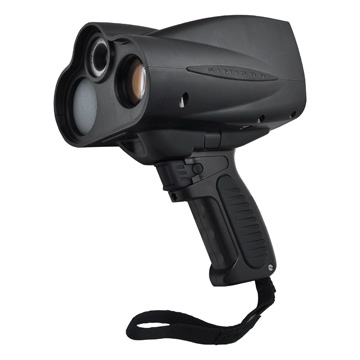 A special feature of the Binar is the presence of two video cameras: the first is for a broad overview of the traffic situation, the second is shooting close-ups of the intruder’s car with a distinguishable number plate at a distance of up to 200 meters. The device is able to work stationary or while driving a DPS patrol car. The presence of two video recordings in addition to the radar readings simplifies the monitoring of the situation on the road and increases the accuracy of identifying the traffic violator. "Binar" is equipped with a non-volatile memory card in SD format, has a low weight, is able to charge from the on-board network of the car and can be synchronized with the computer. The radar is controlled using a remote control or touch screen.
A special feature of the Binar is the presence of two video cameras: the first is for a broad overview of the traffic situation, the second is shooting close-ups of the intruder’s car with a distinguishable number plate at a distance of up to 200 meters. The device is able to work stationary or while driving a DPS patrol car. The presence of two video recordings in addition to the radar readings simplifies the monitoring of the situation on the road and increases the accuracy of identifying the traffic violator. "Binar" is equipped with a non-volatile memory card in SD format, has a low weight, is able to charge from the on-board network of the car and can be synchronized with the computer. The radar is controlled using a remote control or touch screen.
Specifications
Type of device radar videotape
Operating frequency of the speed meter 24050–24250 MHz (K-band)
Driving Directions All Directions
Speed measurement mode stationary, patrol
Detection range up to 300 m
Speed measurement range 20–300 km / h
Measurement error ± 2 km / h
Radar "Radis"
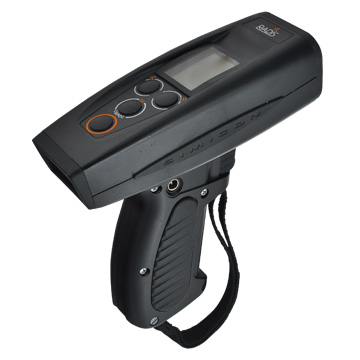 Radar "Radis" has high accuracy and fast measurement speed with the ability to select the nearest or fastest car from the traffic flow. The device is capable of measuring the speed in the opposite and in the same direction, it is equipped with two displays with bright backlighting and has a simple control using the on-screen menu. The radar is capable of measuring the speed, charging from the on-board network of the car. The weight of the device is only 450 g. "Radis" can be installed in the cabin, as well as on the hood or roof of a patrol car using a magnetic stand. Using the remote control, the radar can be controlled remotely.
Radar "Radis" has high accuracy and fast measurement speed with the ability to select the nearest or fastest car from the traffic flow. The device is capable of measuring the speed in the opposite and in the same direction, it is equipped with two displays with bright backlighting and has a simple control using the on-screen menu. The radar is capable of measuring the speed, charging from the on-board network of the car. The weight of the device is only 450 g. "Radis" can be installed in the cabin, as well as on the hood or roof of a patrol car using a magnetic stand. Using the remote control, the radar can be controlled remotely.
Specifications
Type of device radar
Operating frequency of the speed meter 24050–24250 MHz (K-band)
Driving Directions All Directions
Speed measurement mode stationary, patrol
Detection range up to 800 m
Speed range 10–300 km / h
Measurement error ± 1 km / h
Radar "Berkut"
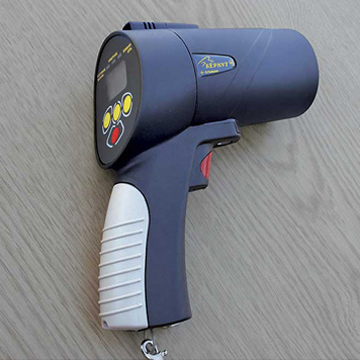 Police radar "Berkut" is designed to control the speed of single vehicles or cars in heavy traffic. Has the ability to choose the nearest or fastest car. The radar is equipped with a backlight indicator and buttons, allowing the traffic police inspector to fix the speed of the car in the dark. "Berkut" can work 10 hours without recharging and measure the speed both permanently and in patrol mode. The radar is easy to use and easily mounted on the dashboard of the car. Depending on the situation, a handle, a bracket or a video clip can be attached to the device.
Police radar "Berkut" is designed to control the speed of single vehicles or cars in heavy traffic. Has the ability to choose the nearest or fastest car. The radar is equipped with a backlight indicator and buttons, allowing the traffic police inspector to fix the speed of the car in the dark. "Berkut" can work 10 hours without recharging and measure the speed both permanently and in patrol mode. The radar is easy to use and easily mounted on the dashboard of the car. Depending on the situation, a handle, a bracket or a video clip can be attached to the device.
Specifications
Type of device radar
Operating frequency of the speed meter 24050–24250 MHz (K-band)
Driving Directions All Directions
Stationary speed measurement mode
Detection range up to 800 m
Speed range 20–250 km / h
Measurement error ± 2 km / h
Radar "Vizir"
 During the speed determination, the Vizir radar carries out a photo and video recording of the intruder’s car, which helps the traffic police inspector in resolving disputable situations. Results of speed measurements, as well as the control date and time are entered into the snapshot taken by Vizir. The device measures in all directions and is able to work both permanently and in the patrol car. The radar is equipped with a built-in LCD display and a simple menu with a convenient location of control keys. The device has the function of automatic speed measurement and recording traffic violations. "Vizir" can be connected to an external monitor and transfer data to a computer.
During the speed determination, the Vizir radar carries out a photo and video recording of the intruder’s car, which helps the traffic police inspector in resolving disputable situations. Results of speed measurements, as well as the control date and time are entered into the snapshot taken by Vizir. The device measures in all directions and is able to work both permanently and in the patrol car. The radar is equipped with a built-in LCD display and a simple menu with a convenient location of control keys. The device has the function of automatic speed measurement and recording traffic violations. "Vizir" can be connected to an external monitor and transfer data to a computer.
Specifications
Type of device radar videotape
Operating frequency of the speed meter 24050–24250 MHz (K-band)
Driving Directions All Directions
Speed measurement mode stationary, patrol
Detection range up to 600 m
Speed range 20–250 km / h
Measurement error ± 2 km / h
Radar complex "Strelka"
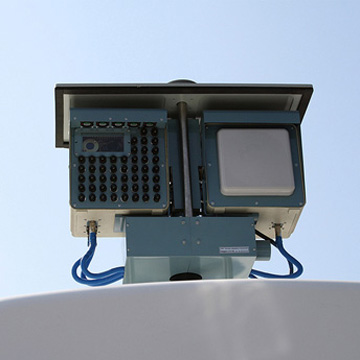 The radar complex "Strelka" accurately measures the speed of all vehicles that fall within its coverage area (500 m from the installation site), regardless of the density of the traffic flow. The "Strelki" camera records the excess of the established speed limit at a distance of 350 to 50 m to the installation site and photographs the vehicle of the intruder with clearly distinguishable license plates. The received data is processed by a computer and transmitted to the information processing center via a fiber-optic line or via a radio channel.
The radar complex "Strelka" accurately measures the speed of all vehicles that fall within its coverage area (500 m from the installation site), regardless of the density of the traffic flow. The "Strelki" camera records the excess of the established speed limit at a distance of 350 to 50 m to the installation site and photographs the vehicle of the intruder with clearly distinguishable license plates. The received data is processed by a computer and transmitted to the information processing center via a fiber-optic line or via a radio channel.
Specifications
Device type radar, photo fixer
Operating frequency of the speed meter 24050–24250 MHz (K-band)
Controlled direction of movement all directions (up to 4 lanes)
Speed measurement mode stationary, patrol
Detection range up to 500 m
Minimum detection range 50 m
Speed measurement range 20–300 km / h
Measurement error ± 1 km / h
The lineup
Strelka-01-ST is a fixed device installed above the carriageway and transmitting information to the control center via fiber-optic communication.
"Arrow-01-CTP" is a stationary device installed above the carriageway and transmitting information to the control center by radio.
Strelka-01-STM is a mobile version of the device that can be placed on a patrol car.
Radar complex "Arena"
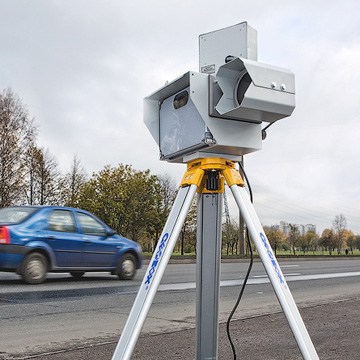 The hardware and software complex "Arena" is designed to automatically control the speed limit on a certain section of the road. Preparation of the complex to work takes about 10 minutes. The Arena is mounted on a tripod 3-5 m from the edge of the roadway. Cars that have exceeded the speed threshold are automatically photographed, and data on violations are transmitted to the traffic police post or stored in the device memory. The radar complex is powered by a battery located nearby in a special box.
The hardware and software complex "Arena" is designed to automatically control the speed limit on a certain section of the road. Preparation of the complex to work takes about 10 minutes. The Arena is mounted on a tripod 3-5 m from the edge of the roadway. Cars that have exceeded the speed threshold are automatically photographed, and data on violations are transmitted to the traffic police post or stored in the device memory. The radar complex is powered by a battery located nearby in a special box.
Specifications
Device type radar, photographic camera, APK
Operating frequency of the speed meter 24050–24250 MHz (K-band)
Controlled driving directions
Stationary speed measurement mode
Detection range up to 90 m
Speed range 20–250 km / h
Measurement error ± 2 km / h
Photoradar complex "Chris"
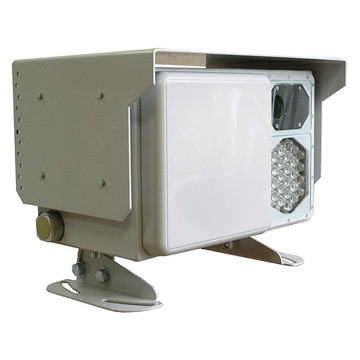 The photo-radar complex “Chris” is designed for automatic recording of traffic violations, recognition of vehicle numbers, checking them against federal or regional bases and transferring data to a remote traffic police post. The device is equipped with an infrared camera, which allows it to work at night. "Chris" is installed on a tripod near the edge of the roadway and will measure the speed of only those cars that are in the frame.
The photo-radar complex “Chris” is designed for automatic recording of traffic violations, recognition of vehicle numbers, checking them against federal or regional bases and transferring data to a remote traffic police post. The device is equipped with an infrared camera, which allows it to work at night. "Chris" is installed on a tripod near the edge of the roadway and will measure the speed of only those cars that are in the frame.
Specifications
Device type radar, photo fixer
Operating frequency of the speed meter 24050–24250 MHz (K-band)
Driving Directions All Directions
Stationary speed measurement mode
Detection range up to 150 m
Speed range 20–250 km / h
Measurement error ± 1 km / h
The lineup
“Chris-S” is a standard model of a photo-radar complex.
"Chris-P" - an improved model with a new photoradar sensor.
Radar "Rapira-1"
 Radar "Rapira-1" is used only for stationary measurement of the speed of vehicles, able to work separately or as part of various hardware and software systems. The radar is installed at a distance of 4-9 meters above the road at an angle of 25 ° and allows you to determine the speed of the car in a narrow zone of control.
Radar "Rapira-1" is used only for stationary measurement of the speed of vehicles, able to work separately or as part of various hardware and software systems. The radar is installed at a distance of 4-9 meters above the road at an angle of 25 ° and allows you to determine the speed of the car in a narrow zone of control.
Specifications
Device type radar, photo fixer
Operating frequency of the speed meter 24050–24250 MHz (K-band)
Controlled driving directions
Stationary speed measurement mode
Detection range up to 20 m
Speed measurement range 20-250km / h
Measurement error ± 2 km / h
Laser radar "Lisd-2"
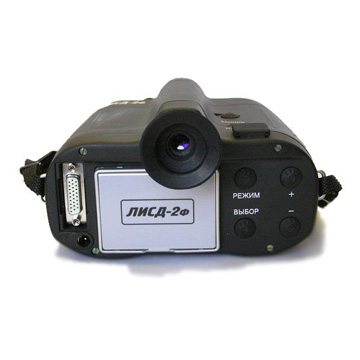 Laser radar "Lisd-2" is designed to measure the speed of movement and the distance to various objects, uses a narrow beam of light that allows you to select a specific car in a dense stream of vehicles. Lidar is made in the form of binoculars with an optical sight, it works only stationary, but measures the speed in all directions. There is a fastening of the shoulder strap and the ability to install the device on a tripod.
Laser radar "Lisd-2" is designed to measure the speed of movement and the distance to various objects, uses a narrow beam of light that allows you to select a specific car in a dense stream of vehicles. Lidar is made in the form of binoculars with an optical sight, it works only stationary, but measures the speed in all directions. There is a fastening of the shoulder strap and the ability to install the device on a tripod.
Specifications
Device type lidar, photo fixer
Laser wavelength 800-1100 nm
Driving Directions All Directions
Stationary speed measurement mode
Detection range up to 400 m
Speed range 1–200 km / h
Measurement error ± 2 km / h
The lineup
“Lisd-2M” is a standard lidar model.
“Lisd-2F” is an improved model equipped with a photofixation unit.
Laser radar "Amata"
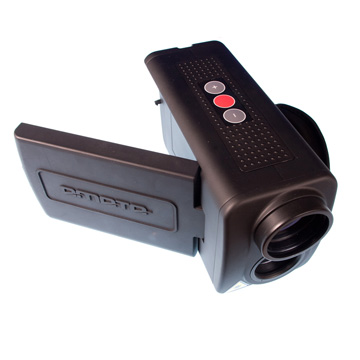 Laser Radar "Amata" is able to accurately measure the speed and distance of vehicles and record traffic violations using photo or video. The device works on the basis of a laser speed meter, which allows you to reliably select the car you need from a dense traffic flow. Lidar "Amata" is equipped with a target mark, which on the device display or in the photo coincides with the direction of the laser beam and is proof of the speed measurement of a particular car.
Laser Radar "Amata" is able to accurately measure the speed and distance of vehicles and record traffic violations using photo or video. The device works on the basis of a laser speed meter, which allows you to reliably select the car you need from a dense traffic flow. Lidar "Amata" is equipped with a target mark, which on the device display or in the photo coincides with the direction of the laser beam and is proof of the speed measurement of a particular car.
Specifications
Device type lidar, photo fixer
Laser wavelength 800-1100 nm
Driving Directions All Directions
Speed measurement mode stationary, patrol
Detection range up to 700 m
Speed measurement range 1.5-280 km / h
Measurement error ± 2 km / h
 The Iskra-1 radar is a reliable and efficient speed meter operating in the K-band. For 15 years, the radar has been successfully used by road monitoring services to control the speed limit on the roads of Russia. Iskra-1 operates at double the frequency of the K-band, which significantly increases the reliability of measurements under adverse weather conditions. A distinctive feature of the Iskra-1 models is a single-pulse method for measuring speed. This mode provides a high speed device: the parameters of the movement of the car radar counts in just 0.2 seconds. At the same time, the radar is almost invisible to all non-adapted for Russian conditions radar detectors of foreign production: they all perceive the Iskra short-pulse signal as a hindrance.
The Iskra-1 radar is a reliable and efficient speed meter operating in the K-band. For 15 years, the radar has been successfully used by road monitoring services to control the speed limit on the roads of Russia. Iskra-1 operates at double the frequency of the K-band, which significantly increases the reliability of measurements under adverse weather conditions. A distinctive feature of the Iskra-1 models is a single-pulse method for measuring speed. This mode provides a high speed device: the parameters of the movement of the car radar counts in just 0.2 seconds. At the same time, the radar is almost invisible to all non-adapted for Russian conditions radar detectors of foreign production: they all perceive the Iskra short-pulse signal as a hindrance.Specifications
Type of device radar
Operating frequency of the speed meter 24050–24250 MHz (K-band)
Driving Directions All Directions
Speed measurement mode stationary, patrol (in motion)
Detection range up to 800 m
Speed range 30–220 km / h
Measurement error ± 1 km / h
The lineup
"Iskra-1B" is designed to work in a stationary mode, mainly in one direction. The radar allows in virtually any conditions to allocate in a traffic flow a vehicle with the highest speed exceeding the flow velocity by only 5 km / h.
The Iskra-1D is the first Russian radar capable of operating in all directions on a moving patrol vehicle. In one second, the radar manages to make a fivefold measurement of its own speed and target speed, eliminate possible errors, process the measurement results and display them on the board, consistently displaying the target speed, its own speed and time from the beginning of the measurement.
Radar "Sokol-M"
 Mobile radar "Sokol-M" is an autonomous radar velocity meter operating in the outdated X-band. The device is designed to determine the speed of oncoming cars only. Overall, easy to use, the radar is able to control the speed of both individual cars and moving in the stream at a distance of 300-500 m. It is perfectly recognized by “white” radar detectors of any price category. The Sokol-M radar was discontinued in 2008, but due to its high reliability, ease of handling and relatively small price, it is widely used now in Russia and the Commonwealth countries.
Mobile radar "Sokol-M" is an autonomous radar velocity meter operating in the outdated X-band. The device is designed to determine the speed of oncoming cars only. Overall, easy to use, the radar is able to control the speed of both individual cars and moving in the stream at a distance of 300-500 m. It is perfectly recognized by “white” radar detectors of any price category. The Sokol-M radar was discontinued in 2008, but due to its high reliability, ease of handling and relatively small price, it is widely used now in Russia and the Commonwealth countries.Specifications
Type of device radar
Operating frequency of the speed meter 10500–10550 MHz (X-band)
Driving Directions All Directions
Speed measurement mode stationary, patrol (in motion)
Detection range up to 600 m
Speed range 20–250 km / h
Measurement error ± 2 km / h
The lineup
Sokol-M-S is designed for stationary control of speed limits and has an adjustable range. All Sokol-M models operate in Ultra-X pulsed mode, which makes these radars hardly perceptible for low-price radar detectors and models that are not adapted for use in the Russian context.
Sokol-MD is designed to measure the speed of oncoming and passing vehicles in a moving patrol vehicle.
Sokol-Visa, a mobile complex for measuring speed and video recording, is a Sokol-M radar, paired with a digital video camera. The system operates in a stationary mode (it is installed mainly on a fixed patrol vehicle) and can measure the speed of oncoming vehicles only. The Sokol-Visa complex captures on video not only speeding violations, but also movement at a red light and the intersection of continuous bands - it is almost impossible to appeal against such a charge of violating traffic rules.
Radar "Binar"
 A special feature of the Binar is the presence of two video cameras: the first is for a broad overview of the traffic situation, the second is shooting close-ups of the intruder’s car with a distinguishable number plate at a distance of up to 200 meters. The device is able to work stationary or while driving a DPS patrol car. The presence of two video recordings in addition to the radar readings simplifies the monitoring of the situation on the road and increases the accuracy of identifying the traffic violator. "Binar" is equipped with a non-volatile memory card in SD format, has a low weight, is able to charge from the on-board network of the car and can be synchronized with the computer. The radar is controlled using a remote control or touch screen.
A special feature of the Binar is the presence of two video cameras: the first is for a broad overview of the traffic situation, the second is shooting close-ups of the intruder’s car with a distinguishable number plate at a distance of up to 200 meters. The device is able to work stationary or while driving a DPS patrol car. The presence of two video recordings in addition to the radar readings simplifies the monitoring of the situation on the road and increases the accuracy of identifying the traffic violator. "Binar" is equipped with a non-volatile memory card in SD format, has a low weight, is able to charge from the on-board network of the car and can be synchronized with the computer. The radar is controlled using a remote control or touch screen.Specifications
Type of device radar videotape
Operating frequency of the speed meter 24050–24250 MHz (K-band)
Driving Directions All Directions
Speed measurement mode stationary, patrol
Detection range up to 300 m
Speed measurement range 20–300 km / h
Measurement error ± 2 km / h
Radar "Radis"
 Radar "Radis" has high accuracy and fast measurement speed with the ability to select the nearest or fastest car from the traffic flow. The device is capable of measuring the speed in the opposite and in the same direction, it is equipped with two displays with bright backlighting and has a simple control using the on-screen menu. The radar is capable of measuring the speed, charging from the on-board network of the car. The weight of the device is only 450 g. "Radis" can be installed in the cabin, as well as on the hood or roof of a patrol car using a magnetic stand. Using the remote control, the radar can be controlled remotely.
Radar "Radis" has high accuracy and fast measurement speed with the ability to select the nearest or fastest car from the traffic flow. The device is capable of measuring the speed in the opposite and in the same direction, it is equipped with two displays with bright backlighting and has a simple control using the on-screen menu. The radar is capable of measuring the speed, charging from the on-board network of the car. The weight of the device is only 450 g. "Radis" can be installed in the cabin, as well as on the hood or roof of a patrol car using a magnetic stand. Using the remote control, the radar can be controlled remotely.Specifications
Type of device radar
Operating frequency of the speed meter 24050–24250 MHz (K-band)
Driving Directions All Directions
Speed measurement mode stationary, patrol
Detection range up to 800 m
Speed range 10–300 km / h
Measurement error ± 1 km / h
Radar "Berkut"
 Police radar "Berkut" is designed to control the speed of single vehicles or cars in heavy traffic. Has the ability to choose the nearest or fastest car. The radar is equipped with a backlight indicator and buttons, allowing the traffic police inspector to fix the speed of the car in the dark. "Berkut" can work 10 hours without recharging and measure the speed both permanently and in patrol mode. The radar is easy to use and easily mounted on the dashboard of the car. Depending on the situation, a handle, a bracket or a video clip can be attached to the device.
Police radar "Berkut" is designed to control the speed of single vehicles or cars in heavy traffic. Has the ability to choose the nearest or fastest car. The radar is equipped with a backlight indicator and buttons, allowing the traffic police inspector to fix the speed of the car in the dark. "Berkut" can work 10 hours without recharging and measure the speed both permanently and in patrol mode. The radar is easy to use and easily mounted on the dashboard of the car. Depending on the situation, a handle, a bracket or a video clip can be attached to the device.Specifications
Type of device radar
Operating frequency of the speed meter 24050–24250 MHz (K-band)
Driving Directions All Directions
Stationary speed measurement mode
Detection range up to 800 m
Speed range 20–250 km / h
Measurement error ± 2 km / h
Radar "Vizir"
 During the speed determination, the Vizir radar carries out a photo and video recording of the intruder’s car, which helps the traffic police inspector in resolving disputable situations. Results of speed measurements, as well as the control date and time are entered into the snapshot taken by Vizir. The device measures in all directions and is able to work both permanently and in the patrol car. The radar is equipped with a built-in LCD display and a simple menu with a convenient location of control keys. The device has the function of automatic speed measurement and recording traffic violations. "Vizir" can be connected to an external monitor and transfer data to a computer.
During the speed determination, the Vizir radar carries out a photo and video recording of the intruder’s car, which helps the traffic police inspector in resolving disputable situations. Results of speed measurements, as well as the control date and time are entered into the snapshot taken by Vizir. The device measures in all directions and is able to work both permanently and in the patrol car. The radar is equipped with a built-in LCD display and a simple menu with a convenient location of control keys. The device has the function of automatic speed measurement and recording traffic violations. "Vizir" can be connected to an external monitor and transfer data to a computer.Specifications
Type of device radar videotape
Operating frequency of the speed meter 24050–24250 MHz (K-band)
Driving Directions All Directions
Speed measurement mode stationary, patrol
Detection range up to 600 m
Speed range 20–250 km / h
Measurement error ± 2 km / h
Radar complex "Strelka"
 The radar complex "Strelka" accurately measures the speed of all vehicles that fall within its coverage area (500 m from the installation site), regardless of the density of the traffic flow. The "Strelki" camera records the excess of the established speed limit at a distance of 350 to 50 m to the installation site and photographs the vehicle of the intruder with clearly distinguishable license plates. The received data is processed by a computer and transmitted to the information processing center via a fiber-optic line or via a radio channel.
The radar complex "Strelka" accurately measures the speed of all vehicles that fall within its coverage area (500 m from the installation site), regardless of the density of the traffic flow. The "Strelki" camera records the excess of the established speed limit at a distance of 350 to 50 m to the installation site and photographs the vehicle of the intruder with clearly distinguishable license plates. The received data is processed by a computer and transmitted to the information processing center via a fiber-optic line or via a radio channel.Specifications
Device type radar, photo fixer
Operating frequency of the speed meter 24050–24250 MHz (K-band)
Controlled direction of movement all directions (up to 4 lanes)
Speed measurement mode stationary, patrol
Detection range up to 500 m
Minimum detection range 50 m
Speed measurement range 20–300 km / h
Measurement error ± 1 km / h
The lineup
Strelka-01-ST is a fixed device installed above the carriageway and transmitting information to the control center via fiber-optic communication.
"Arrow-01-CTP" is a stationary device installed above the carriageway and transmitting information to the control center by radio.
Strelka-01-STM is a mobile version of the device that can be placed on a patrol car.
Radar complex "Arena"
 The hardware and software complex "Arena" is designed to automatically control the speed limit on a certain section of the road. Preparation of the complex to work takes about 10 minutes. The Arena is mounted on a tripod 3-5 m from the edge of the roadway. Cars that have exceeded the speed threshold are automatically photographed, and data on violations are transmitted to the traffic police post or stored in the device memory. The radar complex is powered by a battery located nearby in a special box.
The hardware and software complex "Arena" is designed to automatically control the speed limit on a certain section of the road. Preparation of the complex to work takes about 10 minutes. The Arena is mounted on a tripod 3-5 m from the edge of the roadway. Cars that have exceeded the speed threshold are automatically photographed, and data on violations are transmitted to the traffic police post or stored in the device memory. The radar complex is powered by a battery located nearby in a special box.Specifications
Device type radar, photographic camera, APK
Operating frequency of the speed meter 24050–24250 MHz (K-band)
Controlled driving directions
Stationary speed measurement mode
Detection range up to 90 m
Speed range 20–250 km / h
Measurement error ± 2 km / h
Photoradar complex "Chris"
 The photo-radar complex “Chris” is designed for automatic recording of traffic violations, recognition of vehicle numbers, checking them against federal or regional bases and transferring data to a remote traffic police post. The device is equipped with an infrared camera, which allows it to work at night. "Chris" is installed on a tripod near the edge of the roadway and will measure the speed of only those cars that are in the frame.
The photo-radar complex “Chris” is designed for automatic recording of traffic violations, recognition of vehicle numbers, checking them against federal or regional bases and transferring data to a remote traffic police post. The device is equipped with an infrared camera, which allows it to work at night. "Chris" is installed on a tripod near the edge of the roadway and will measure the speed of only those cars that are in the frame.Specifications
Device type radar, photo fixer
Operating frequency of the speed meter 24050–24250 MHz (K-band)
Driving Directions All Directions
Stationary speed measurement mode
Detection range up to 150 m
Speed range 20–250 km / h
Measurement error ± 1 km / h
The lineup
“Chris-S” is a standard model of a photo-radar complex.
"Chris-P" - an improved model with a new photoradar sensor.
Radar "Rapira-1"
 Radar "Rapira-1" is used only for stationary measurement of the speed of vehicles, able to work separately or as part of various hardware and software systems. The radar is installed at a distance of 4-9 meters above the road at an angle of 25 ° and allows you to determine the speed of the car in a narrow zone of control.
Radar "Rapira-1" is used only for stationary measurement of the speed of vehicles, able to work separately or as part of various hardware and software systems. The radar is installed at a distance of 4-9 meters above the road at an angle of 25 ° and allows you to determine the speed of the car in a narrow zone of control.Specifications
Device type radar, photo fixer
Operating frequency of the speed meter 24050–24250 MHz (K-band)
Controlled driving directions
Stationary speed measurement mode
Detection range up to 20 m
Speed measurement range 20-250km / h
Measurement error ± 2 km / h
Laser radar "Lisd-2"
 Laser radar "Lisd-2" is designed to measure the speed of movement and the distance to various objects, uses a narrow beam of light that allows you to select a specific car in a dense stream of vehicles. Lidar is made in the form of binoculars with an optical sight, it works only stationary, but measures the speed in all directions. There is a fastening of the shoulder strap and the ability to install the device on a tripod.
Laser radar "Lisd-2" is designed to measure the speed of movement and the distance to various objects, uses a narrow beam of light that allows you to select a specific car in a dense stream of vehicles. Lidar is made in the form of binoculars with an optical sight, it works only stationary, but measures the speed in all directions. There is a fastening of the shoulder strap and the ability to install the device on a tripod.Specifications
Device type lidar, photo fixer
Laser wavelength 800-1100 nm
Driving Directions All Directions
Stationary speed measurement mode
Detection range up to 400 m
Speed range 1–200 km / h
Measurement error ± 2 km / h
The lineup
“Lisd-2M” is a standard lidar model.
“Lisd-2F” is an improved model equipped with a photofixation unit.
Laser radar "Amata"
 Laser Radar "Amata" is able to accurately measure the speed and distance of vehicles and record traffic violations using photo or video. The device works on the basis of a laser speed meter, which allows you to reliably select the car you need from a dense traffic flow. Lidar "Amata" is equipped with a target mark, which on the device display or in the photo coincides with the direction of the laser beam and is proof of the speed measurement of a particular car.
Laser Radar "Amata" is able to accurately measure the speed and distance of vehicles and record traffic violations using photo or video. The device works on the basis of a laser speed meter, which allows you to reliably select the car you need from a dense traffic flow. Lidar "Amata" is equipped with a target mark, which on the device display or in the photo coincides with the direction of the laser beam and is proof of the speed measurement of a particular car.Specifications
Device type lidar, photo fixer
Laser wavelength 800-1100 nm
Driving Directions All Directions
Speed measurement mode stationary, patrol
Detection range up to 700 m
Speed measurement range 1.5-280 km / h
Measurement error ± 2 km / h
Radar detector
Legality
The use of radar detectors is officially authorized in Russia, Ukraine, Belarus, Moldova, Kazakhstan and all other countries of the Commonwealth, in the USA (except for the state of Virginia and in Washington, DC), Great Britain, Iceland, Bulgaria, Romania, Slovenia, Albania, Israel, Japan, India, Pakistan, Taiwan, New Zealand.
Radar detectors are prohibited for use in Canada (except British Columbia, Alberta and Saskatchewan), Brazil, Finland, Norway, Sweden, Belgium, Ireland, Switzerland, Denmark, Germany, Austria, Holland, Luxembourg, France, Portugal, Italy , Greece, Croatia, Serbia, Slovakia, Poland, Hungary, Bosnia, Czech Republic, Estonia, Latvia, Lithuania, Turkey, Jordan, Singapore, Malaysia, Egypt, Saudi Arabia, United Arab Emirates, South Africa, Australia (excluding the state of Western Australia).
Story

The world's first radar detector for motorists
Promoted such gadgets through the magazine Popular Electronics (1961):

A source
Later models:


Museum of radar detectors - www.radardetectormuseum.com
The insides of a modern radar detector SHO-ME 520 STR

Bottom view

With the radiator removed (corrected in the comments - this is an RF screen. It also shields the local oscillator radiation, and also protects the receiving path from external interference. Thanks r00tGER ). On the left above is a laser detector, below is a copper horn antenna. In the center - the RF module. To the right - 3 control buttons. Right (white) - display

Under HF screen

a detailed description of the component on a similar device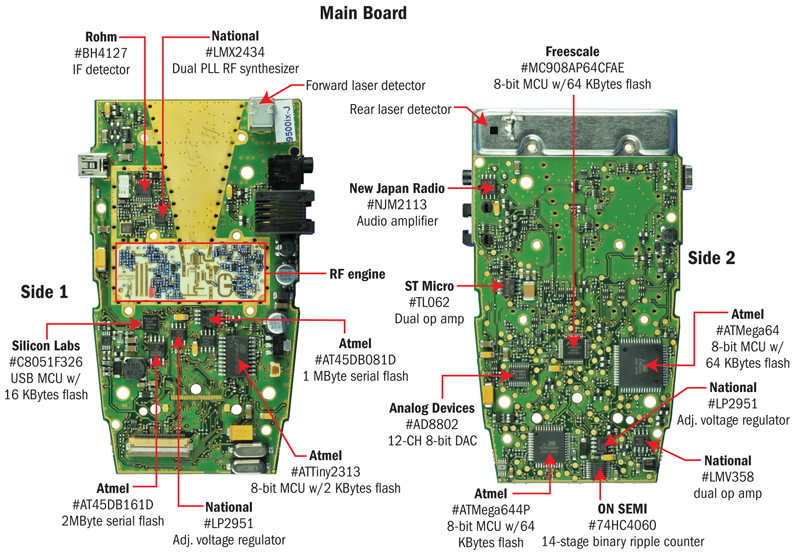

False signals are radio signals from outside devices operating in police radar bands, but with no relation to the latter. For example, automatic shop doors can operate in the X- and K-bands, satellite equipment signals can be detected by the X-band radar detector, radio signals from all bands can be detected in areas adjacent to airports, as well as laser signals.
The radar detectors use software and hardware methods of protection against spurious radio signals. Hardware methods involve the installation of specialized filters in the receiving device of the radar detector, and software methods include special algorithms that can identify the radar signal and cut off its signal from interference. But sometimes these methods are not enough, especially when using a radar detector in urban environments with a lot of interference from foreign devices. To do this, all modern radar detectors have a manual change in the sensitivity of the device - switching between the "City" and "Route" modes. Depending on the “jamming” environment, the driver can independently adjust the sensitivity of his device and minimize the number of false alarms of the radar detector.
Active Radar

Antiradar - the device of the active type. It is equipped not only with a radio receiver for signal detection, but also with a radio transmitter that emits signal-to-noise. It is this signal that violates the work of police radar: it mixes the signal coming from the radar with radio noise (“white noise”). The radar radio receiver receives a distorted signal and cannot determine the speed of the vehicle to which the radio signal was directed.
These devices are prohibited almost everywhere. This device is included in the list of devices included in the Law “On counteraction to traffic organs”.
Laser Antiradar
During their work in response to the signal sent by the police radar, the laser anti-radar detectors send their own out-of-phase. As a result, the policeman gets a speed value that is too low. It should be noted that the range of prices for devices of this type is significant. This is explained both by the brand of the manufacturer and its “promotion” on the market, and by the method of manufacture and the components used. The most expensive are laser anti-radars of a hidden or separated installation, as well as capable of simultaneously processing a large number (up to eight) signals at the same time, determining the power and signal level.
The use of “jammers” against lidars is also not recommended, since they are already included in the list of the Law “On Countering Road Traffic Organs”.
Demonstration of laser jammer:
Radar Detector Detector

Highly sensitive direction finder
In a number of foreign countries, according to the law, radar detectors are prohibited. In order to determine whether a radar detector is in a car or not, the VG-2 system (16000 MHz) was invented. The principle of operation - the car is irradiated with a signal of a certain frequency, since Inside the radar detector there are a lot of radio parts, they induce a “noise” on this signal and, by their presence or absence, the device issues whether the radar detector is in the car or not.
Modern radar detectors have the function of detecting VG-2 devices (in fact, when a VG-2 is detected, the radar simply turns off for a while).
All radar detectors can be divided into 2 main groups - heterodyne and direct amplification. Direct amplification detectors cannot initially be detected by such devices. they have no structural radiation. In heterodyne detectors in the process of signal processing uses the local oscillator, which is the source of radiation (minimal, but there). It is this radiation that can be captured by ultrasensitive devices for searching a radar detector at a distance. The distance can reach several hundred meters.
With the VG-2 option in the detector, the radar detector, besides the usual radar frequencies, also scans this selected frequency for the signal of such an instrument. When a signal is detected, all the local oscillators in the detector are turned off, and with them the reception of radar signals and thus the detector is protected from detection. The detector is fully turned on only after the signal disappears in the VG-2 range.
In addition to the VG-2, which is already an outdated technology, there are Spectrum-type devices that also remotely detect the presence of a heterodyne radar detector in a car. Unlike VG-2, the Spectrum does not have a dedicated frequency and therefore cannot be detected in advance. The only protection against detection by Spectra is to reduce the level of radiation of the local oscillator due to shielding and the use of low-noise signal amplifiers.
Counteraction to the detector of radar detectors
1. Not to use a local oscillator in the design of the radar detector - there are no radiating elements, there is no problem, but the direct-amplification radar detector is not very sensitive;
2You can counteract VG-2 systems by turning off the local oscillator, and this is done in most radar detectors. As soon as the radar detector detects a signal in the VG-2 range, it turns off the local oscillator and thus interferes with detection. When using this method, there is one very important side effect - at the time of detecting a VG-2 signal, the radar detector cannot detect radar signals since its local oscillator is disabled. This method works only with VG-2, and Spectrum systems have a different principle and this method is not possible.
3To counteract Spectra manufacturers radar detector all available methods to reduce the radiation emitted by the local oscillator to the outside. For this, shielding, metal shells are used, resonance tuning is one of the passive methods. Active include the use of low-noise amplifiers (LNA), the reduction of the local oscillator, etc. methods. The use of several methods at the same time is able to protect the radar detector from detecting, but radar detectors that are not completely detectable is not much, but their number is constantly increasing as manufacturers move to higher technologies. The first completely undetectable radar detector was the Beltronics STi. When using this method of counteraction there are no side effects.
In Russia, the functions of VG and Specter are not relevant, since we do not have a ban on the use of radar detectors, although in the media every now and then there are notes about attempts by the authorities of individual regions to impose such restrictions, such as in Tatarstan.
A large box catches a small box:
DIY
What is happening in the environment of DIY and hacker conferences

Scheme for self-assembly radar detector for radio amateurs (1958)
How to gash your radar. In detail
The hacker's job of making coffee cans radar is based on the scientific publication of a doctor from MIT, where the ability to create 2D and 3D images using radar synthesizing aperture is described.

Massachusetts even made a course on this topic
DEFCON 19: Build your own Synthetic Aperture Radar:
For 900 bucks you can buy a set for the assembly :

Anboxing training set with cans:
Device for testing radar detectors and laser jammers

Test your radar detector or laser jammer with
this traffic enforcement LIDAR gun simulator If you want to build your own laser jammer or laser radar detector, it is useful to you is a device that simulates the work of police laser detection systems.
The device mimics one of 11 systems:
- Jenoptik laveg
- Jenoptik LaserPatrol
- Kustom Prolaser 1
- Kustom Prolaser 2
- Kustom Prolaser 3
- Kustom ProLite
- Laser atlanta
- Stalker LZ-1
- Ultralyte 100/200 LR Revision 1
- Ultralyte 100/200 LR Revision 2
- Ultralyte Non-LR
each of which works on 904nM, some systems emit 100 pulses per second, some - 238.
We test our gadget for vulnerabilities.
Radar Gun Hacked!

From a toy:

For $ 25
With a saw, washer and bottle:

Make a device for those who want to become a policeman:

Need more power
Another comrade was not satisfied with the power of the previous "toy" (10 meters), and he washed down his horn antenna and amp:

Handyman wants to measure the speed of airplanes. He figured out the relics, but the next step is to upgrade the microchip, because it has a speed limit of 100 mph and he needs more. ( Source )
Hack Old School Police Radar

Nadybav in the attic of grandfather's radar, the craftsman poked around with the oscilloscope and soldered the adapter from the radar to the laptop through the audio input. And then successfully processed the signal on the computer.
a source
PS
Bearded story
I-15, .
, , .
… 500 /.
, , .
, - , , F/A-18 Hornet (- -), .
.
:
« . , , . , , , .
, „-“, , .
, , , , , , , .
, , - . , , , . , .
, .
.
Semper Fi»
, , .
… 500 /.
, , .
, - , , F/A-18 Hornet (- -), .
.
:
« . , , . , , , .
, „-“, , .
, , , , , , , .
, , - . , , , . , .
, .
.
Semper Fi»
Source: https://habr.com/ru/post/261891/
All Articles